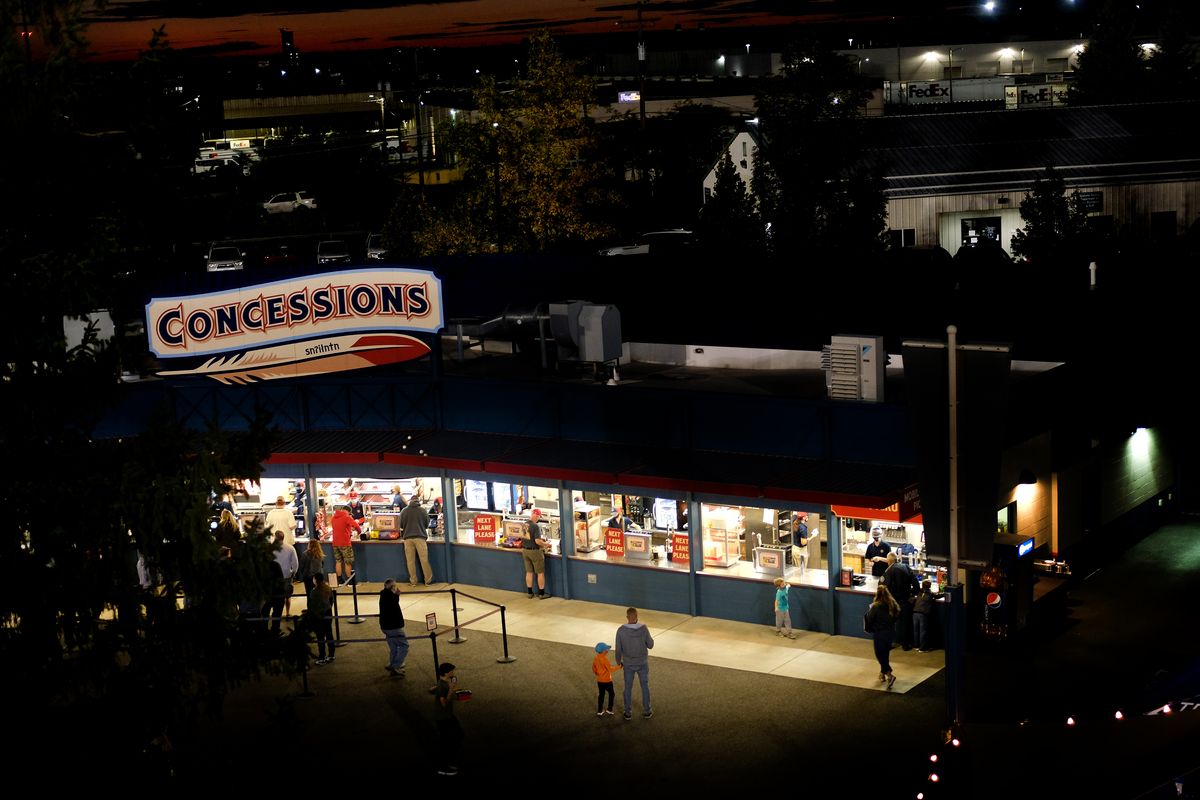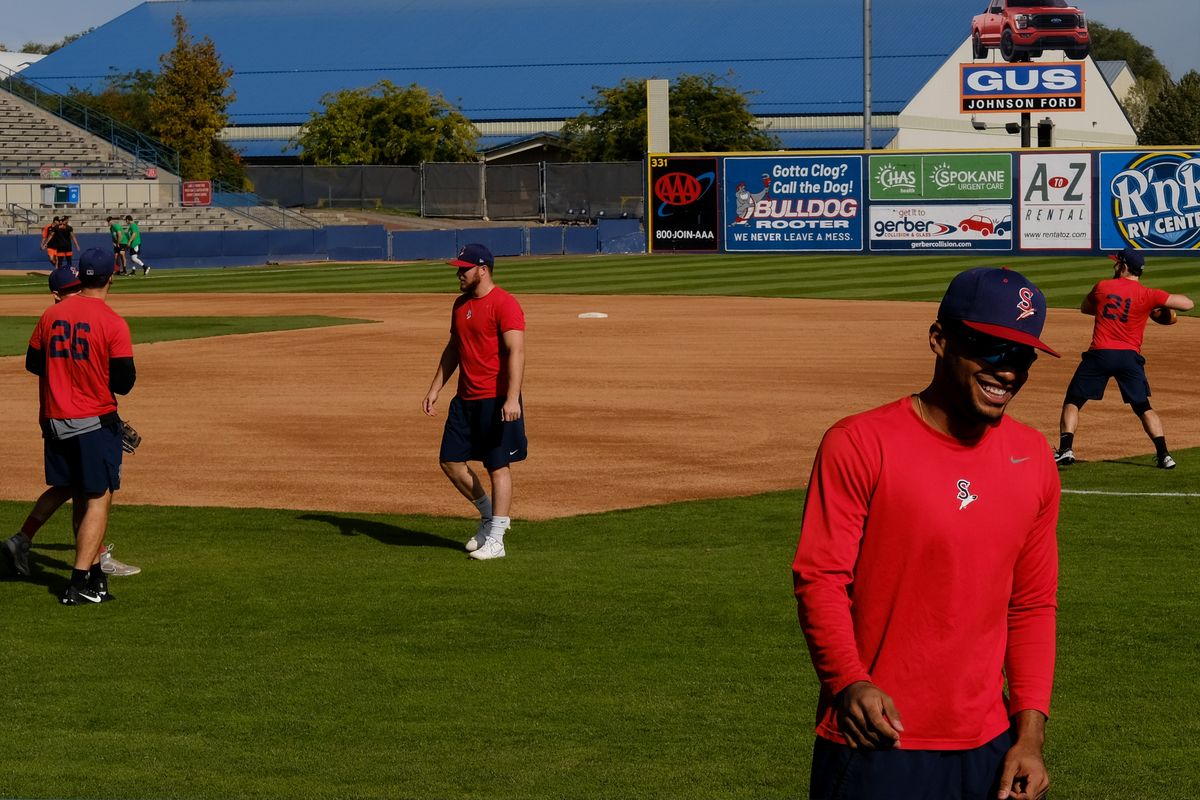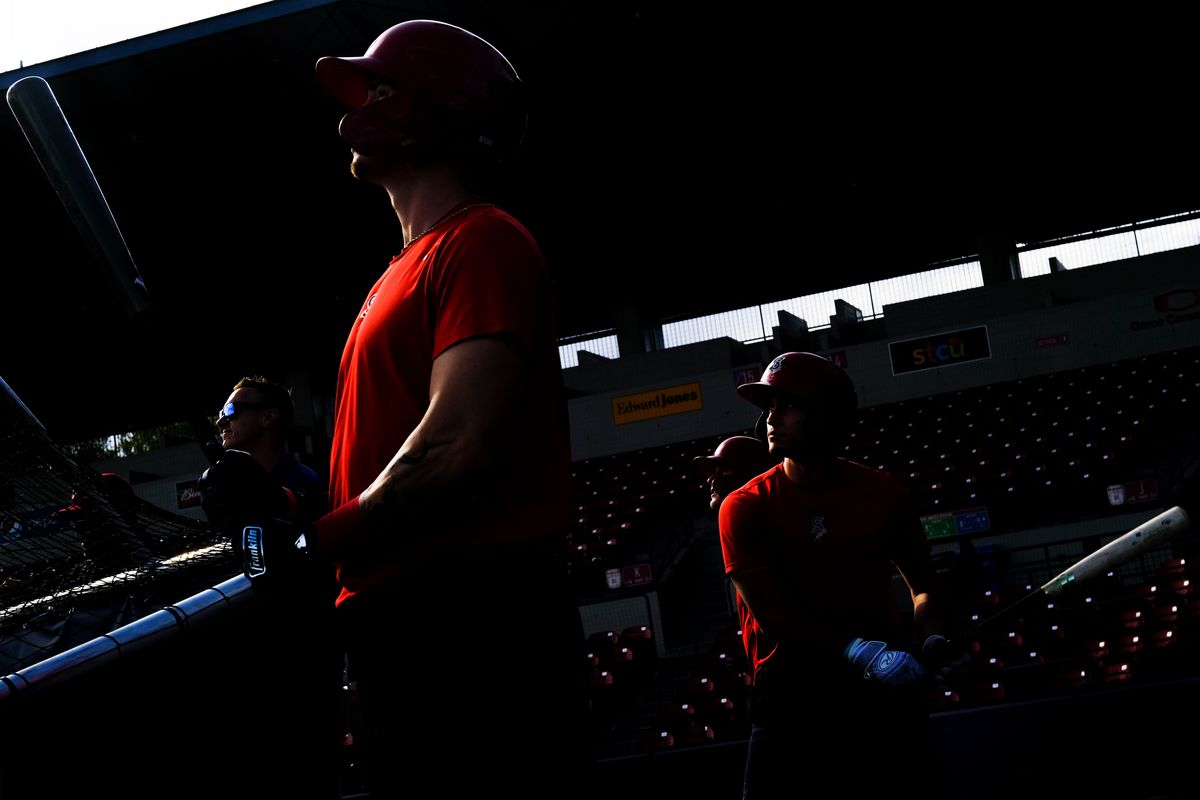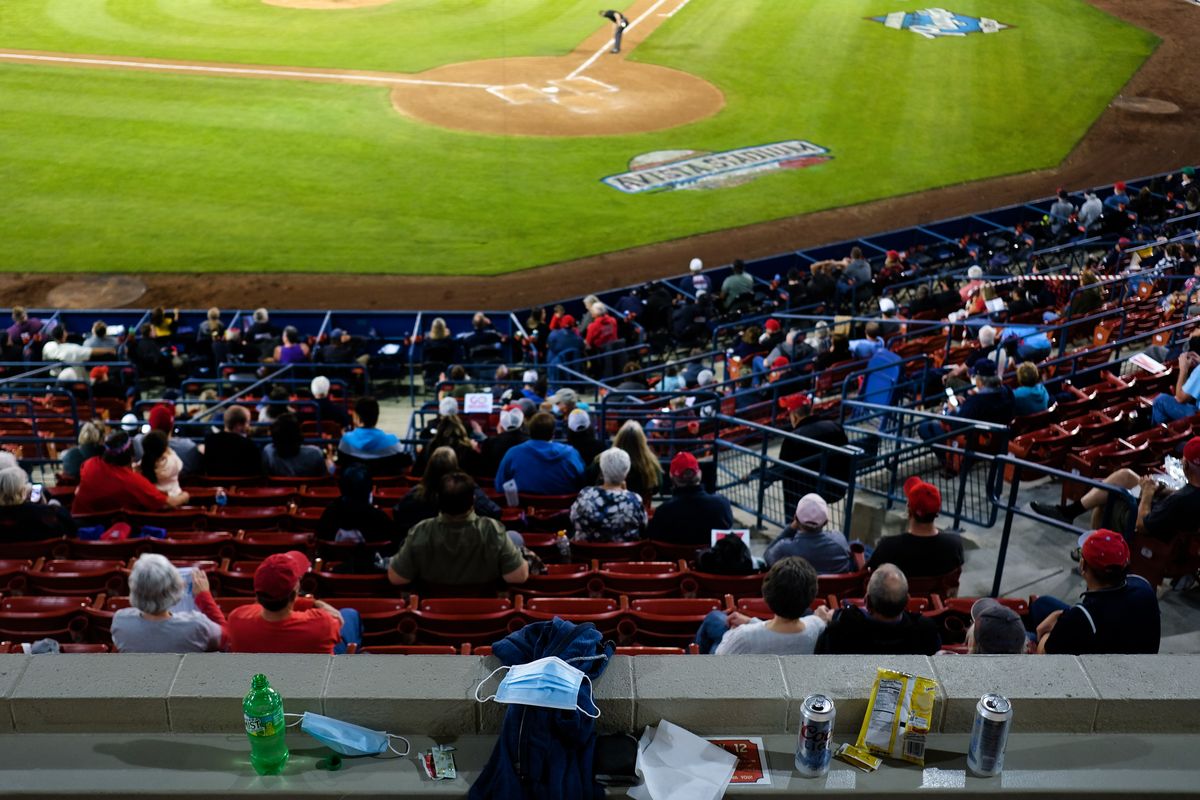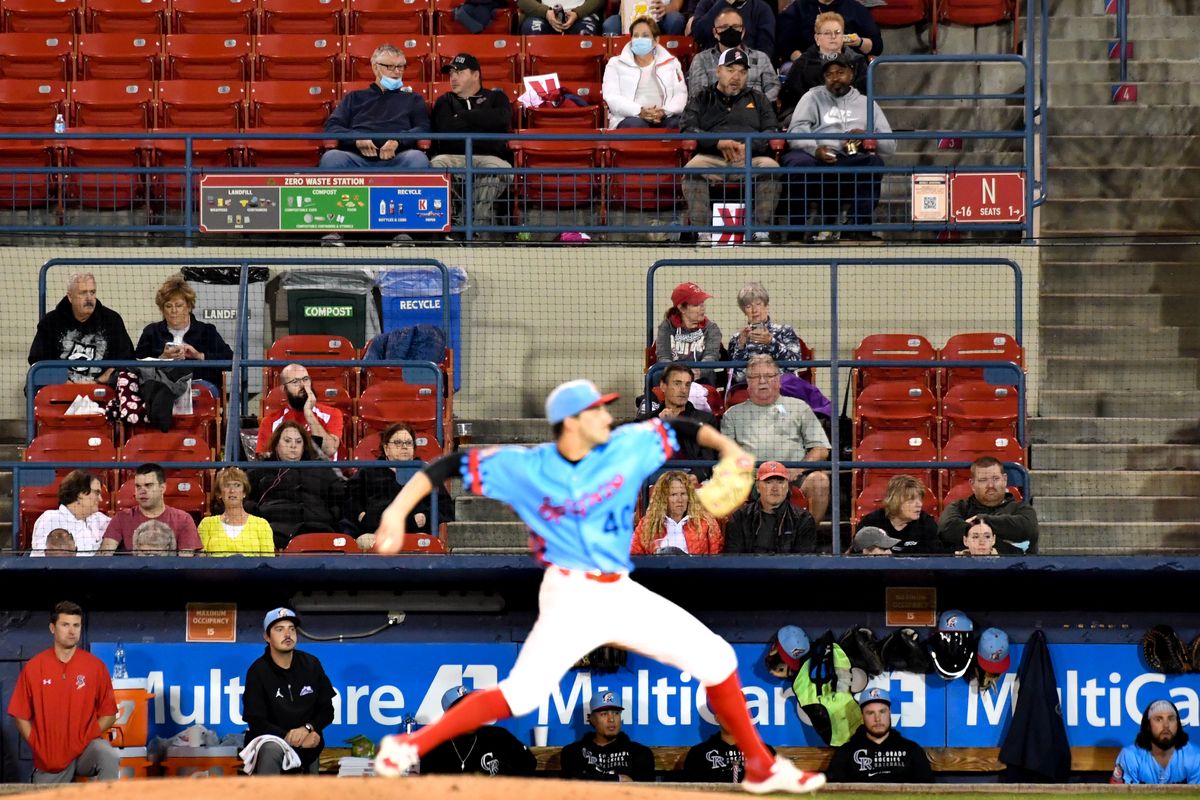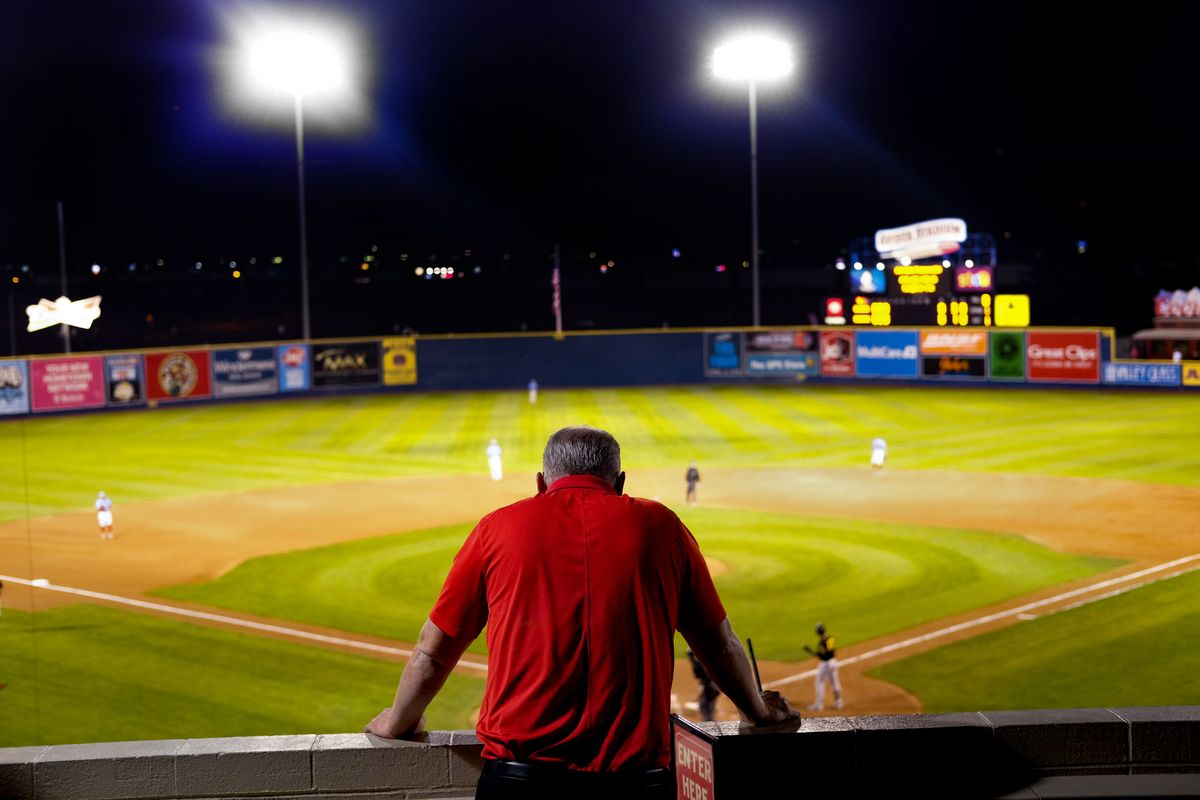Was 2021 the Spokane Indians’ most exciting season ever? Players, workers and fans describe the ups and downs of pandemic baseball

No one in Avista Stadium is yelling louder than Joni Koontz.
She has a guttural yell, a plug-your-ears-if-you’re-standing-next-to-her kind of holler. There’s a sense of urgency to it.
“C’MON JAAAACK!” she screams at Spokane Indians batter Jack Blomgren, the second baseman.
The score is 0-0 in the bottom of the fifth inning. This is Game 2 of the High-A West championship series between the Indians and the Eugene Emeralds. It’s Wednesday night, and the Indians are down 0-1 in the series.
Koontz stands on the third base side of the walkway that divides the upper and lower tiers of seats in the stands. She has glasses, gray hair under her red Indians cap and a red Indians shirt. Indians earrings, with pictures of mascot Doris the Spokanasaurus on them, dangle from her ears. At first glance she looks like a team employee, and she says people often mistake her for one.
“Just a fan,” she says.
She’s a fan who typically comes to 10 or so games a year. In 2020, when the COVID-19 pandemic forced the cancellation of minor league baseball, Koontz was left without a team to cheer for.
“It was boring,” she says.
Losing baseball was emotionally devastating for fans, players and team employees alike. For lovers of America’s pastime, a summer without baseball isn’t much of a summer at all. Many say they felt empty without going to the ballpark.
The return of Indians baseball in 2021 would have been welcome regardless of COVID-19 impacts.
Still, the unprecedented season has been difficult. On top of COVID-19 limitations, wildfire smoke, extreme heat and drought all caused problems. Fireworks nights were canceled. Attendance never bounced back to 2019 levels.
And yet, despite the negatives, many say this unique year has been one of the greatest in Indians’ history.
The team moved up the minor-league ranks from Low A to High A, which expanded the season from 76 to roughly 120 games. After 18 years as a Texas Rangers affiliate, the team joined the Colorado Rockies organization. Most memorably, the Indians ended the season on a historic hot streak, going 30-9 after Aug. 1 and rocketing up the standings to snag a playoff berth.
Given all that’s happened in the last two years, many say it’s only fitting for the season to end with a battle for the High-A West championship.
“They deserve a championship, they really do,” Koontz says. “These guys played their hearts out.”
Spokane Indians’ outfielder Daniel Montano smiles during a practice before facing the Eugene Emeralds on Wednesday at Avista Stadium in Spokane. (Tyler Tjomsland/The Spokesman-Review)Buy a print of this photo
Batting practice
At 3 p.m. the Indians warm up in right field, a cluster of men in red shirts and blue shorts. They swing their arms, touch their toes and jog casually back and forth. It’s 70-something degrees with blue skies and white clouds, a perfect day for baseball.
Except for music coming out of the stadium loudspeakers, the field’s quiet until the team starts playing catch and the satisfying pop of baseballs smacking into gloves carries through the air.
From the mid-1980s until 2020, Indians Manager Scott Little heard that sound nearly every day, all summer long.
Little is stocky and gruff, a man of few words. Dark sunglasses cover his eyes, and even when he’s talking he rarely looks away from his players as they get loose.
In 1984, the New York Mets drafted an 18-year-old Little in the 7th round. He worked his way up to the major leagues with the Pittsburgh Pirates, earning four at bats in 1989 and going 1-for-4. He never played in the majors again and became a coach in 1992.
Because he’s spent his whole adult life in professional baseball, 2020 was the first time Little spent a whole year at home.
“It was odd,” he says.
After a season away, nobody cared about COVID-related inconveniences, Little says. Players and coaches were “willing to do anything we needed to do” to play.
From May through July, the Indians didn’t play like a championship contender. At the start of August they had a losing record and sat a daunting 14.5 games back in the standings.
No sane gambler would put much money on a team overcoming a 14.5-game deficit. The 2021 team would be remembered as the pandemic year squad, but it didn’t seem destined to win a spot in anyone’s heart.
Inside the clubhouse, the attitude was different. It sounds crazy, Little says, but even going into August the team thought it could make the playoffs. The players had a “never say die,” mentality, he says.
“We played old time baseball,” he says. “We ran, we bunted, we got runs in.”
After warming up, the Indians prepare for batting practice. They roll out the L-screen, lay protective mesh on the grass in front of home plate and carry a bucket of balls to the mound.
Indians second and third baseman Aaron Schunk, a 24-year-old Georgian, says he feels grateful he got to play baseball this year.
Not being able to high-five fans and being told not to socialize with teammates – to limit COVID-19 transmission – was unpleasant, Schunk says, but those were relatively small issues.
Schunk was fired up when opening day 2021 arrived.
“The one word would be joy, I think,” he says. “And that goes for everybody.”
A second-round pick in 2019, Schunk has struggled this year. His .223 batting average is far below the impressive .306 mark he managed with the Boise Hawks in his first pro season two years ago.
But he grins when talking about making it to the playoffs. Playoff baseball’s always fun, he says.
Shelby Lackey, a tall, lanky relief pitcher with a tuft of red beard on his chin and a mid-90s fastball, says he hasn’t been a part of a late-season winning streak like the Indians had.
“Coming to the ballpark every day we knew we were going to win,” he says.
Lackey spits on the ground, then kicks some dirt on top of the loogie.
“It was probably the most special thing I’ve been a part of playing baseball,” he says.

The press box
Up in the press box, behind home plate, Indians radio broadcaster Mike Boyle has one of the best seats in the house. He’s got a bird’s-eye view of the field and the pine-covered hills in the distance.
For thousands of Spokanites, listening to Boyle’s deep, clear voice over the radio has been a summer constant for a decade. It was strange not to hear him last year.
Being off the air felt strange to Boyle, too. He grimaces when he thinks about the lost season.
“It really was hard mentally,” he says. “It was a challenge to just keep yourself up and positive.”
When the baseball season began, Boyle felt mixed emotions. He was ecstatic to return to the booth, but with attendance capped at 25% of capacity, the energy on opening day was disappointingly low.
“It was thrilling and different all at the same time,” he says, adding that the whole season has felt off due to smaller crowds even though more fans came out as the summer dragged on.
Few people have followed the Indians closer than Boyle since he took over full play-by-play duties in 2011. The man who’s watched thousands of baseball games says this team’s torrid run at the end of the year was incredible.
“We didn’t hit .500 until August,” he emphasizes, getting excited as he describes the turnaround. “To actually watch it unfold was one of the most remarkable things I’ve ever witnessed, and I’ve seen a lot of baseball.”
This has been one of the best seasons Boyle’s ever watched.
“It’s been one of the most fun,” he says, checking his audio levels before the pregame show starts at 6 p.m. “For the first year back, I don’t think you could draw up the script any better.”

The grounds crew
When the Emeralds finish batting practice at about 5 p.m., the grounds crew gets to work.
One man drives small circles around the infield dirt in what looks like a stubby lawnmower, towing a rake to smooth out any imperfections. One checks the pitcher’s mound to make sure it’s ready. Another lays down fresh, white chalk to mark the base lines and batter’s boxes.
Jeremy Headley, the Indians’ 20-year-old, mustachioed head groundskeeper, has been keeping Avista Stadium’s field in tip-top shape for two years now. Last year, with the season canceled, he worked at Costco and Granite Point Resort. He says he’s glad to be back working on the field.
Headley’s humble about the spiffy designs he mows on the grass. For instance, those perfectly mown circles around the pitcher’s mound? That’s easier to do than you’d think, he says, because once you trace the first ring you have a line to follow.
Despite his modesty, Headley’s proud of the grounds crew’s work. He mentions, matter of factly, that Avista Stadium has won the Northwest League of Professional Baseball’s Field of the Year award a bunch of times in a row.
Like everyone else, Headley says it was cool to watch the Indians make up 14.5 games in the standings and grab a playoff berth. But one of his 2021 reflections stands out.
When the Indians moved up to High A, the pitchers got better, he says. They throw harder and have better breaking pitches. The result?
“A lot more foul balls.”
The fans
The game’s still scoreless in the bottom of the seventh. A nearly full moon hangs over the left field fence and the Indians have runners on first and second with one out.
Tonight’s a school night and the stands aren’t close to full – 1,741 fans are here and Avista holds 7,000 – but the crowd’s the loudest it’s been, sensing a rally.
“Double steal, noodle arm’s catching,” a fan shouts.
Two of the Indians’ most loyal fans, seniors Pat and Sanford Foster, are watching the drama unfold from their seats behind home plate.
Before this season, the Fosters didn’t consider themselves baseball fans. They’d been to Indians games a mere handful of times. This year, they’ve been at all but two home games.
The Fosters say they don’t have a good explanation for why they suddenly love baseball so much.
“I just went to the ticket office and kind of got carried away,” Sanford Foster says seriously, adding he and his wife have gotten hooked and plan on coming to just as many games next year.
The crowd boos in unison when the home plate umpire calls a strike against Indians’ batter Daniel Montano, putting the left-fielder down in the count 1-2.
Fans sit on the edge of their seats to watch the most important pitch of the game so far, trying to will Montano to knock in a run.
A loud groan fills the stadium when the lefty strikes out swinging. Daniel Cope, the catcher, hits a weak pop up to second base a few pitches later, stranding the runners on first and second. Some fans take that as their cue and head to the exits.

Steve and Lisa Tompkins, sitting behind the Indians’ dugout on the first base side, aren’t going anywhere.
The Tompkins have been season ticket holders for 14 years. Not going to Indians games in 2020 was tough, they say.
“This is our summertime family,” Lisa Tompkins says.
Steve Tompkins has watched Indians games since he was a kid. He remembers when Ron Cey, who would later become a Los Angeles Dodgers legend, played for the team in 1971.
The Cey team isn’t one of Tompkins’ two favorites though. His top two of all-time are the 2018 team and this one.
It’s the top of the ninth now, two down, and the Emeralds have men on first and second. A ground ball off the bat of an Emeralds’ hitter sneaks through the infield for a single, putting Eugene on top 1-0.
“Dang it,” Steve Tompkins says angrily.
The crowd grows quiet, then quieter still when the next Emeralds’ batter hits a double that knocks in two more runs, putting the Indians down 0-3.
“Oh come on,” Steve Tompkins says.
The double sparks a mass exodus from the stands. Vickie “Grandma Vickie” Mularski, an Indians section manager who’s been helping fans find their seats for 12 years, walks upstream against the flow of people heading home.
She leans over the railing when she reaches her friends, the Tompkins.
“I have to say, it’s over,” she says, dejected.
Then she corrects herself.
“It ain’t over till the fat lady sings.”
(Two days later, the Indians went on to lose the series in four games.)

The front office
Uncertainty has dominated the last two years for Spokane Indians Senior Vice President Otto Klein.
Until June 2020, teams didn’t know for sure that the minor league season would be canceled. Plus, Major League Baseball announced a dramatic minor league restructuring in 2020 and the Indians front office didn’t know where the team would end up in the shuffle.
Even after the team learned it’d be moving to the High-A West and joining the Colorado Rockies, 2021 was a roller coaster.
At the start of the season, Gov. Jay Inslee’s COVID-19 mandates forced the team to limit attendance to 25% capacity. Capacity and mask requirements ended up shifting throughout the year, but in June the team was hopeful that the worst effects of the pandemic were over.
“Fourth of July we thought we were out of the woods,” Klein says.
Then in August, COVID-19 case counts and hospitalizations began to rise again. Klein says he expects some fans were nervous about the delta variant and chose to stay home. Wildfire smoke and record-breaking heat throughout the summer probably depressed attendance too, he says.
The last two home games of the year were canceled due to “COVID-19 concerns” among the visiting Tri-City Dust Devils. Klein says losing those games was heartbreaking.
“Those would have been the two biggest crowds of the year,” he says.
Financially, 2021 will be a year to forget, Klein says, but he’s also incredibly proud of how staff have handled the last two years.
“Businesswise we’re down, but accomplishments wise …” he says. “I think it’s been one of the greatest seasons in Spokane Indians history.”
Paid to watch baseball
Superfan Joni Koontz hears someone in the stands behind her heckle the Indians’ batter and shakes her head.
The chirping is coming from a group of Emeralds’ front office staff who traveled from Eugene to watch the championship games, she says. This entire series will be played in Spokane, instead of alternating between the two cities, because the Emeralds are field-less at the moment. The University of Oregon Ducks baseball team kicked them out to make way for college fall ball.
“They don’t even have a field and their front office is calling us cupcakes,” Koontz says in disgust. “It’s not right that you do that to the other team.”
Alex Gustafson, the section manager for this part of the stands, confirms the boisterous group is the Emeralds’ front office staff.
Gustafson, who has a black beard under his mask, started working for the Indians six years ago when he was a senior in college. He wants to work in a baseball front office someday. Until then, he’s happy being a section manager, a job he describes as “a cross between a security guard and a cheerleader.”
“Even on the worst day you get paid to watch baseball,” he explains.
Multiple section leaders say the lack of baseball in 2020 hurt, but Gustafson took the loss harder than most. He says he felt depressed and empty not coming to the ballpark. Being at the stadium again means a lot to him.
“It didn’t matter if we sold 70 tickets or 70,000,” he says. “Baseball was back.”

